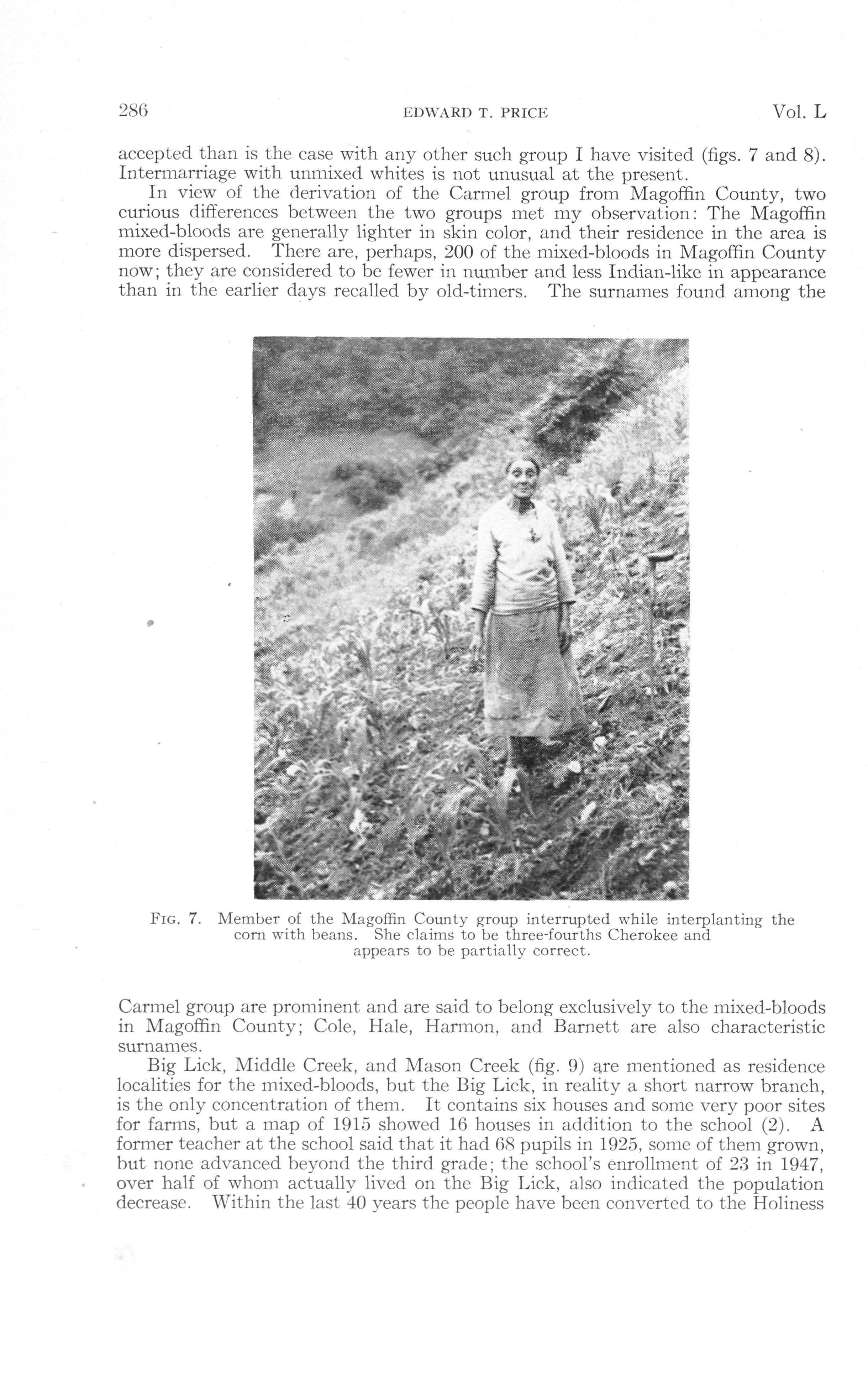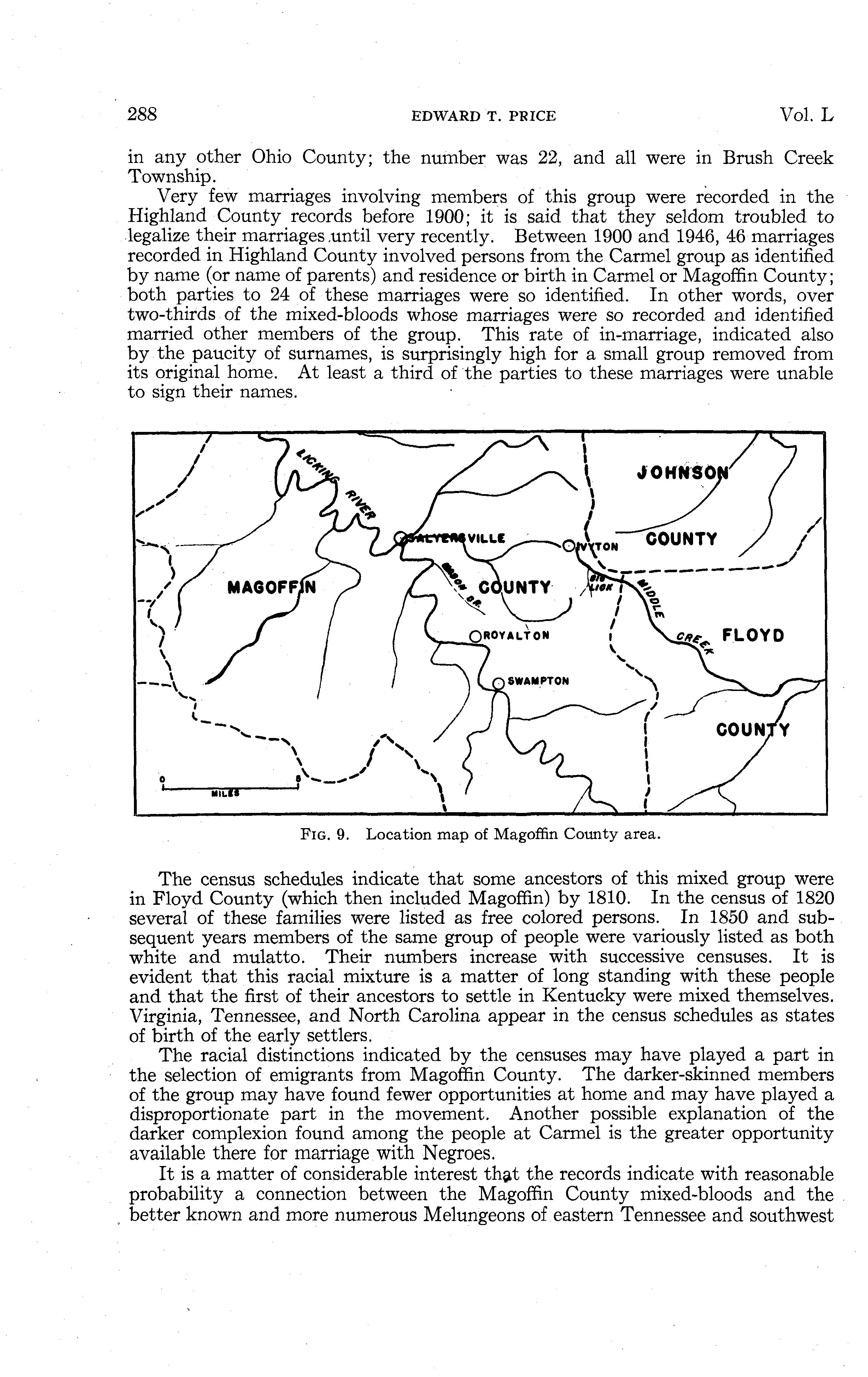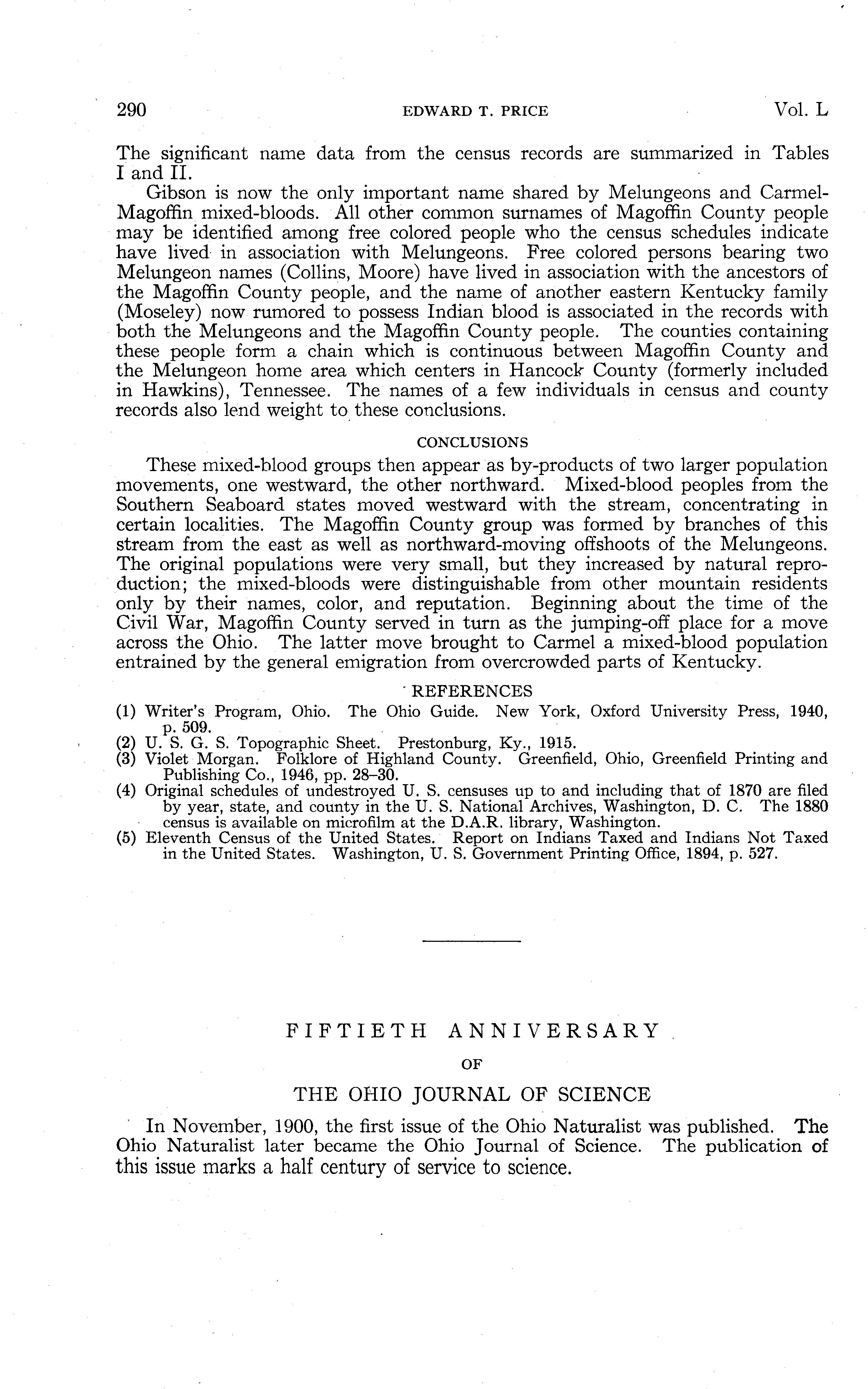THE MIXED-BLOOD RACIAL STRAIN OF CARMEL, OHIO, AND MAGOFFIN COUNTY, KENTUCKY
EDWARD T PRICE
Department of Geology and Geography
University of Cincinnati, Cincinnati, Ohio
A number of population groups of dark-skinned peoples, recognized as socially distinct in rural localities of eastern United States, are commonly assumed to be tri-racial, mixed from white, Negro, and Indian ancestors A small example of such a group is mentioned by The Ohio Guide (1) as living in the vicinity of Carmel in Highland County. Aside from another small mixed-blood settlement of very different circumstances in Darke County, this group near Carmel is probably the only one to be found rooted in Ohio.

FIG 1 Location map showing Carmel and Magoffin Cotinty 281
MIXED-BLOODS OF CARMEL
Carmel is a cross-roads hamlet based on a school, a church, and a country store. Its location on the margin of the Till Plains, half surrounded by the wooded hills which mark the western edge of the Appalachian Plateau, is probably significant for the phenomenon which brings it this notice (figs. 1 and 2).
The "half-breeds" or "Carmel Indians," as they are locally identified, are well known to the farmers of the vicinity, who, on the surface at least, accept good-naturedly the claim of the former to Indian ancestry. Privately the question of Negro blood also may be raised Most of the older residents think that both are present and can name families or individuals who they think illustrated each type in the days before the mixing was so thorough. The group look mixed; a few of them are nearly white, but most are identifiable by their brown or tan skin; many of them have curly black hair, and many have straight black hair. Few, if any, really look like Indians, but identifying negroid features are not usual I consider it likely that Indian and Negro mixtures are both present on the basis that the degree of pigmentation in most of the people otherwise seems inconsistent with their general lack of negroid features (figs. 3, 4, and 5).

The surnames of the members of this group are, with few exceptions, Gibson (Gipson), Nichols, and Perkins. One or two other names have recently been added to the group by marriage. Some of the Gipsons aver that the Gibsons have a trace of Negro blood In the summer of 1947 their number was determined to be at least 150;the population is said to have been somewhat larger in times past. These half-breeds usually reside in the hilly part of the Carmel environs. Their homes are characteristically one-room shacks, a few of which are mudchinked log cabins. Some live as tenants on farms of the vicinity; in recent years a few have been able to purchase small tracts of land Traditionally they have been squatters, taking advantage of the unused hill land, tolerated by the owners as long as they seemed useful to the community as a source of farm labor. A group of shacks occupied in one of the hollows is known as ''Pocahontas Row.''
In addition to sporadic work on farms, the Carmelites have supported themselves in various ways, partly from the hill lands where they hunt squirrels and ground-hogs (in season or out) for food, dig ginseng (Patiax quinquefolium) and yellowroot (Hydrastis canadensis) for sale to herb houses through the local stores, and obtain wood for fuel and building. Most of them keep chickens, which run in and out of the houses freely in summer, and some keep pigs. Many cultivate
No. 6 MIXED RACIAL STRAIN, CARMEL, OHIO
small garden patches, and occasionally one may have the land for a corn crop. Petty theft, particularly of feed grains, has been attributed to them. One family, apparently not connected with the others, has made a business of weaving and

selling baskets Various public welfare payments have contributed to their support in recent years, to the great irritation of their neighbors.
In cultural terms the Carmel Indians represent an intrusion of the Kentucky Mountains into the Middle West. The country people are quick to point out their
EDWARD T. PRICE
differences in language—the prevalence of non-grammatical phrases and the use of old forms such as "holp" and "poke;" "hit" is common for "it," and "lamp oil" is the phrase for kerosene. The laundry is boiled in the outdoor kettle, and the more industrious string their "shuck beans" on the porch to dry out and produce a supply of food for winter (fig. 6). In their numerous progeny and in their general family relations they also correspond closely to the rural Ohioan's concept of Kentuckians
The Carmelites are considered extremely shiftless by their neighbors; it is the characteristic belief (perhaps worthy of study itself) that nothing can be done for them which will permanently raise their low standards. This impression of an ambitionless existence is supported by direct observation of some of|the people.

The visitor is likely to find most of the residents of a house in a sitting or reclining position One with whom I talked had planned a tobacco crop, but had only poor excuses for not having started it by mid-June. Malnutrition might well provide a physiological basis for the continuance of this inertia, which few incentives seem to overcome
The cultural peculiarities are not needed for determining the source of the mixed breeds, for it is common knowledge in the community that Magoffin County, Kentucky, is their original home. Many of the present residents were born in Magoffin County, and they return there frequently for visits, some wintering in Kentucky regularly. Lack of economic opportunity was apparently the reason for their leaving Magoffin County, and, indeed, some of the Carmel people move on north for seasonal employment in the Scioto onion marshes or work on railroad gangs. Carmel, however, has the aspect of home to many of these people, and they are likely to come back again On returning to Carmel, they may move into vacant shacks or, finding the old homes torn down, move in with neighbors It is a standing joke in the community that one never knows how many people he may find living in one of the shacks
The termination of their original northward movement at Carmel is probably a matter of chance, but, once arrived, they found an ecological niche which offered them the needed sources of support The juxtaposition of reasonably good agricultural land and steep hill land replete with the hollows of an irregular boundary seems to have offered in one locality farms prosperous enough to provide employment and a refuge for residence locations; their shacks are sheltered from the winds of the open plains and from easy observation; they are off the arable land whose use the farmer would refuse, but accessible to building material, fuel, food, and a source of supplementary cash. The farmer in his turn gained a source of labor which would not only not demand high wages, but may not have even desired steady work.

MIXED-BLOODS OF MAGOFFIN COUNTY
Investigation of Magoffin County as the source of the Carmel people soon disclosed that it too, with adjacent sections of Floyd County, is the home of a mixed group Magoffin is a typical Kentucky Mountain County with little to distinguish it from many others The better farming land is in the narrow valleys, the poorer on the lower slopes of the hills. As in most of the mountain counties, Negroes are almost completely lacking.
The mixed-bloods are accepted without serious question as to origin or status Many of them own farms, some of the hillside variety, others of somewhat better nature. In Magoffin County their ownership of submarginal land is traditional, whereas in Carmel it is new. They are usually considered to be part Indian, though a few people prefer to call it Negro, and they have been famous for their large families and their ability to keep them going without apparent means of support. Many have also been farm laborers. Their habits of ridge farming and of hunting with their numerous dogs are usually attributed to their Indian blood.
Most of the Magoffin County mixed-bloods who are recognizable today have straight black hair, rarely wavy. The suggestion of Indian blood is more easily
accepted than is the case with any other such group I have visited (figs. 7 and 8). Intermarriage with unmixed whites is not unusual at the present.
In view of the derivation of the Carmel group from Magoffin County, two curious differences between the two groups met my observation: The Magoffin mixed-bloods are generally lighter in skin color, and their residence in the area is more dispersed. There are, perhaps, 200 of the mixed-bloods in Magoffin County now; they are considered to be fewer in number and less Indian-like in appearance than in the earlier days recalled by old-timers. The surnames found among the

Carmel group are prominent and are said to belong exclusively to the mixed-bloods in Magoffin County; Cole, Hale, Harmon, and Barnett are also characteristic surnames.
Big Lick, Middle Creek, and Mason Creek (fig 9) are mentioned as residence localities for the mixed-bloods, but the Big Lick, in reality a short narrow branch, is the only concentration of them. It contains six houses and some very poor sites for farms, but a map of 1915 showed 16 houses in addition to the school (2). A former teacher at the school said that it had 68 pupils in 1925, some of them grown, but none advanced beyond the third grade; the school's enrollment of 23 in 1947, over half of whom actually lived on the Big Lick, also indicated the population decrease. Within the last 40 years the people have been converted to the Holiness
sect, which has erected a church at the mouth of the stream. This area was dominated by the Cole family and is yet known as the "Cole Nation."
The conversation of the Magoffin County mixed-bloods confirms the conclusion that the different families in scattered parts of the country are closely related Some of this group also migrate to the onion marshes and other places where seasonal employment may be obtained.

HISTORY OF THE MIXED-BLOODS
Some members of both the Carmel and Magoffin County groups claim Cherokee Indian ancestry and refer to forebears who came from "Old Virginia" or Tennessee. The story of their origin told by white residents of Carmel involves settlement nearby of a slave-holding family from Virginia shortly before the Civil War It asserts that the slaves, who were named Nichols, were freed by their move into Ohio, but continued to live in the community and married the later immigrants from Kentucky, who bore the names of Gibson and Perkins. On the. other hand a county historian (3), who has long been interested in the backward peoples of the locality, thinks that Shawnee Indians surviving in the area formed the nucleus of the group and that they have only recently mixed with the immigrants from Magoffin County.
The census records (4) support neither of the last two accounts. The first trace of these mixed people at Carmel appears in the 1870 schedules and shows that all of them had ties with Magoffin County Five families listed as mulatto in Brush Creek Township (Carmel) included three Gibsons, a Nichols, and a Perkins. Some of the older members of these families were born in Virginia and Tennessee. In 1880 the count of these families was: Nichols 10, Perkins 2, Gibson 1; all the family heads were born in Kentucky. As a matter of interest, the census of 1890 (5) recorded more Indians resident in Highland County than
EDWARD T. PRICE
in any other Ohio County; the number was 22, and all were in Brush Creek Township
Very few marriages involving members of this group were recorded in the Highland County records before 1900; it is said that they seldom troubled to legalize their marriages.until very recently. Between 1900 and 1946, 46 marriages recorded in Highland County involved persons from the Carmel group as identified by name (or name of parents) and residence or birth in Carmel or Magoffin County; both parties to 24 of these marriages were so identified In other words, over two-thirds of the mixed-bloods whose marriages were so recorded and identified married other members of the group. This rate of in-marriage, indicated also by the paucity of surnames, is surprisingly high for a small group removed from its original home. At least a third of the parties to these marriages were unable to sign their names.

The census schedules indicate that some ancestors of this mixed group were in Floyd County (which then included Magoffin) by 1810. In the census of 1820 several of these families were listed as free colored persons. In 1850 and subsequent years members of the same group of people were variously listed as both white and mulatto. Their numbers increase with successive censuses. It is evident that this racial mixture is a matter of long standing with these people and that the first of their ancestors to settle in Kentucky were mixed themselves. Virginia, Tennessee, and North Carolina appear in the census schedules as states of birth of the early settlers
The racial distinctions indicated by the censuses may have played a part in the selection of emigrants from Magoffin County. The darker-skinned members of the group may have found fewer opportunities at home and may have played a disproportionate part in the movement. Another possible explanation of the darker complexion found among the people at Carmel is the greater opportunity available there for marriage with Negroes.
It is a matter of considerable interest that the records indicate with reasonable probability a connection between the Magoffin County mixed-bloods and the better known and more numerous Melungeons of eastern Tennessee and southwest
6 MIXED RACIAL STRAIN, CARMEL, OHIO 289
Virginia. This case rests on the identification of mixed-bloods in the records by two conservative properties: their surnames andtheir classification as free persons of color or mulattoes; this method isconsidered valid because of the facts that the census records list few free persons of color aside from those bearing the names of present interest, and that these names are usually grouped when they do appear.
TABLE I
NAMES OF MELUNGEONS AND MAGOFFIN COUNTY MIXED-BLOODS
Recognized Names
Collins
Gibson
Goins
Mullins
Moore
Minor
Delph

Melungeon Today
Williams
Bamett (?)
Freeman
Sexton
Bolen
Bell
Mize
Recognized Names of Magoffin County Group
Gibson
Perkins
Nichols
Cole
Collins (?)
Hale
Harmon
Barnett
TABLE II
SELECTED CENSUS DATA ON FREE COLORED FAMILIES BEARING NAMES COMMON AMONG THE MELUNGEONS AND MAGOFFIN COUNTY MIXED-BLOODS
County
Known Melungeon localities:
Wilkes
Hawkins
Claiborne. Cocke
Letcher
Possible Melungeon locality
Campbell Counties between Melungeon and Magoffin areas
Pike
Harlan Knox
Magoffin-Floyd area
Floyd
State N C Term Tenn. Tenn Ky.. Tenn Ky Ky. Ky. Ky.
Name
Nichols. Hale Cola
Moseley. Cole
Nichols. Nicholas Perkins. Perkins
Moseley. Gipson. Collins. Cole
Harmon Goins
Goings.
Moore. Mosley. Moore. Mosley
(In 1947 both Floyd and Knott Counties, Ky., had people named Moseley who are considered to have Indian blood.)
EDWARD T PRICE
The significant name data from the census records are summarized in Tables I and II
Gibson is now the only important name shared by Melungeons andCarmelMagoffin mixed-bloods. All other common surnames of Magoffin County people may be identified among free colored people who the census schedules indicate have lived in association with Melungeons. Free colored persons bearing two Melungeon names (Collins, Moore) have lived in association with the ancestors of the Magoffin County people, and thename of another eastern Kentucky family (Moseley) now rumored to possess Indian blood is associated in the records with both the Melungeons and the Magoffin County people The counties containing these people form a chain which is continuous between Magoffin County and the Melungeon home area which centers in Hancock County (formerly included in Hawkins), Tennessee. Thenames of a few individuals in census and county records also lend weight tothese conclusions.
CONCLUSIONS
These mixed-blood groups then appear as by-products oftwo larger population movements, one westward, the other northward. Mixed-blood peoples from the Southern Seaboard states moved westward with the stream, concentrating in certain localities. TheMagoffin County group was formed by branches of this stream from the east as well as northward-moving offshoots of the Melungeons The original populations were very small, but they increased by natural reproduction; the mixed-bloods were distinguishable from other mountain residents only by their names, color, and reputation. Beginning about the time ofthe Civil War, Magoffin County served in turn as thejumping-off place for a move across the Ohio. The latter move brought to Carmel a mixed-blood population entrained by the general emigration from overcrowded parts of Kentucky.
• REFERENCES
(1) Writer's Program, Ohio. The Ohio Guide. New York, Oxford University Press, 1940, p 509
(2) U S G S Topographic Sheet Prestonburg, Ky., 1915
(3) Violet Morgan. Folklore of Highland County. Greenfield, Ohio, Greenfield Printing and Publishing Co., 1946, pp 28-30
(4) Original schedules of undestroyed U. S. censuses up to andincluding that of 1870 are filed by year, state, and county in the U S National Archives, Washington, D C The 1880 census isavailable on microfilm at the D.A.R. library, Washington.
(5) Eleventh Census of the United States. Report on Indians Taxed and Indians Not Taxed in the United States Washington, U S Government Printing Office, 1894, p 527

FIFTIETH
ANNIVERSARY OF
THE OHIO JOURNAL OF SCIENCE
In November, 1900, the first issue ofthe Ohio Naturalist was published. The Ohio Naturalist later became the Ohio Journal of Science. Thepublication of this issue marks a half century of service to science.
